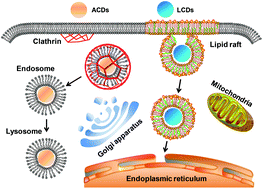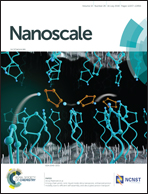Targeted imaging of the lysosome and endoplasmic reticulum and their pH monitoring with surface regulated carbon dots†
Abstract
Organelles play crucial roles in cellular activities and the functions of organelles are related greatly to the pH values, therefore, the bio-imaging of targeted organelles and their related pH sensing is of great importance in biological assays. Herein we report the fluorescence imaging of specific organelles, i.e., lysosomes and endoplasmic reticulum, and their pH sensing with surface regulated carbon dots (CDs). Carbon dots functionalized with amine groups (ACDs) are first prepared by hydrothermal treatment of citric acid and urea, and then laurylamine functionalized CDs (LCDs) are obtained via the conjugation of laurylamine with ACDs. The as-prepared ACDs and LCDs provide clear and bright imaging results for the lysosome and endoplasmic reticulum, respectively. The subcellular targeting features of the two CDs are attributed to their surface chemistries and cellular uptake pathways. Moreover, both the CDs are pH responsive within a certain pH range, i.e., 4.0–5.4 for ACDs and 6.2–7.2 for LCDs. The ACDs and LCDs are thus successfully applied to visualize the pH fluctuations of the lysosome and endoplasmic reticulum in MCF-7 cells.



 Please wait while we load your content...
Please wait while we load your content...